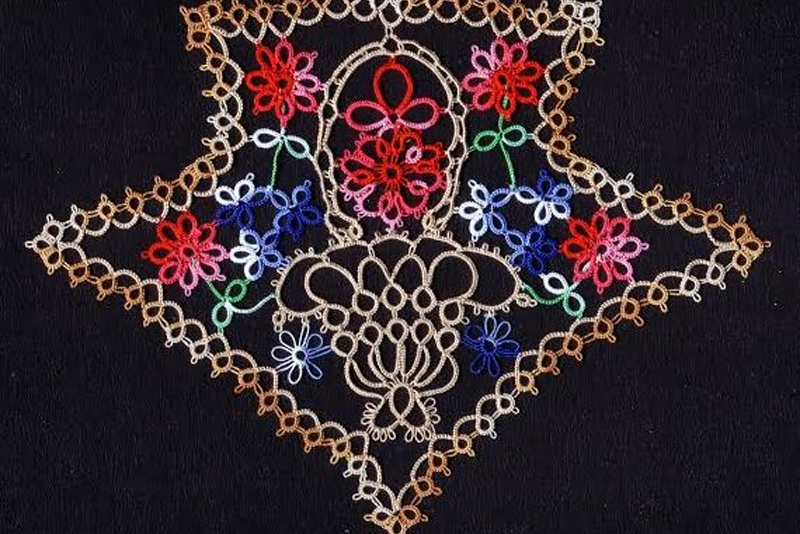Which would I rather have, time or money? Time! More time to tat, of course. Just yesterday I planned to sit on the porch, read, tat and sip chai iced tea. Instead I spent a couple of hours on the feather bed cowering under the covers enduring another lightning storm. So I tried again today but now the bees are all over the porch as the petunia is blooming and the bright orange of the canna lily blossoms sent out a siren's scent tempting them to linger. So no tatting on the porch today.
I came into the office and picked up the first tatting book on the pile in the corner. (I've been organizing my tatting reference library by language and then by author. I have lined up over 50 magazine style book holders and had to open another pack of 50 and still the pile of books to be labeled never lessens.) The book was a collection of the patterns by Eleonore Endrucks-Leichtenstern for which the tatters in the Online Tatting Class had been making new samples to illustrate and to modernize the patterns.
I flipped trough a few pages of the book and paused at #28. Not a large doily nor complicated, but my eyes caught sight of the many dotted lines leading from the center out to the edge. Eleonore had designed the doily to be tatted without cutting the thread! But... there were no split rings, no split chains, just doubles of the chain to return along the path just tatted to exit. For the time that was quite acceptable but we can do better today.

Using two shuttles, one shuttle and ball or needle and ball thread, begin in the center with a round ring and climb out to the next round.
1. R 2, (- 2) x7, 2 clr, mock picot for the 8th picot
2. CH 3 - 3 + (shuttle lock join to the next free standing picot) and continue around until the last chain
3. CH 3, split chain, anchor thread to the climb out picot and cover it with wrapped ds back to the spot where the chain ended. Secure chain and climb out with another mock picot into the next round of all chains.
4. CH 6 - 6 - 6 + (shuttle lock join to the center picot of previous round 3 chains)
Continue around until the last chain. Stop at the last picot and make another split chain by anchoring the thread to the climb out picot and wrap 6 ds over the bare thread of the shuttles back to the last picot made. Climb out into the next round
5. CH 3 + (join to the first picot on the chain below) 6 + (join to the second picot on the same chain)
Repeat around until the last chain, + (shuttle lock join to previous climb out picot, mock picot into the next round.
6. On this round there are two floating rings on every other chain segment. Climb out and then CH 4 DNRW
*Using shuttle 2 R 6 - 6 - 6 - 6 clr. DNRW Leave no space.
R 6 + (join to last picot of previous ring) 6 - 6 - 6 clr DNRW
CH 4 + (join in the same place as previous round), 4 + (join in the same place as previous round) CH 4 DNRW
Repeat from * and cont. around. If desired the last segment may be worked with split rings and split chains but for convenience, secure ends and restart.
For ease of work, turn the doily over and tat the first small ring. Using RODS for the all front/back side look
R 6 + (join between the two rings of previous round) 6 clr. rw
CH 4 + (join to side picot of large ring)
CH 3 - 3 - 3 - 3 - 3 - 3 + (join to side picot of next large ring)
CH 4 rw, R 6 + (join between the two rings of previous round) 6 clr. rw
CH 4 + (join to side picot of next large ring)
Continue in like manner until the last chain. Make the last picot and then use a split chain for the last 3 ds, join,and return to that spot to climb out. For ease of work rw after split chain is complete.
*R 5 - 5 clr DNRW CH 3 + (shuttle lock join to next free picot on chain for previous round), for a total of 5 rings. CH 8 and repeat until the last chain. Do not tat the last small ring, instead make the split chain of 8 ds and return to climb out through the last small ring which is tatted as a split ring.
CH 6 + (join to ring below), ( 4 + (join to ring below)) x4, 6, and continue around.
Climb out into the last round where the previous round started.
CH 3 between each join or picot.

Enjoy!
http://www.bellaonline.com/articles/art28249.asp
Here's the latest article from the Tatting site at BellaOnline.com.
Boutonniere French, undated, saved by the Antique Pattern Library. For those who are thinking about teaching or who like to tat vintage patterns, this little pattern is a great teaching lesson. (Errors in translation are the editor's.)
http://www.bellaonline.com/articles/art304416.asp
Please visit tatting.bellaonline.com for even more great content about Tatting. To participate in free, fun online discussions, this site has a community forum all about Tatting located here -
http://forums.bellaonline.com/ubbthreads.php?ubb=postlist&Board=39
I hope to hear from you sometime soon, either in the forum or in response to this email message. I thrive on your feedback! Have fun passing this message along to family and friends, because we all love free knowledge!
Georgia Seitz, Tatting Editor http://tatting.bellaonline.com One of hundreds of sites at BellaOnline.com







